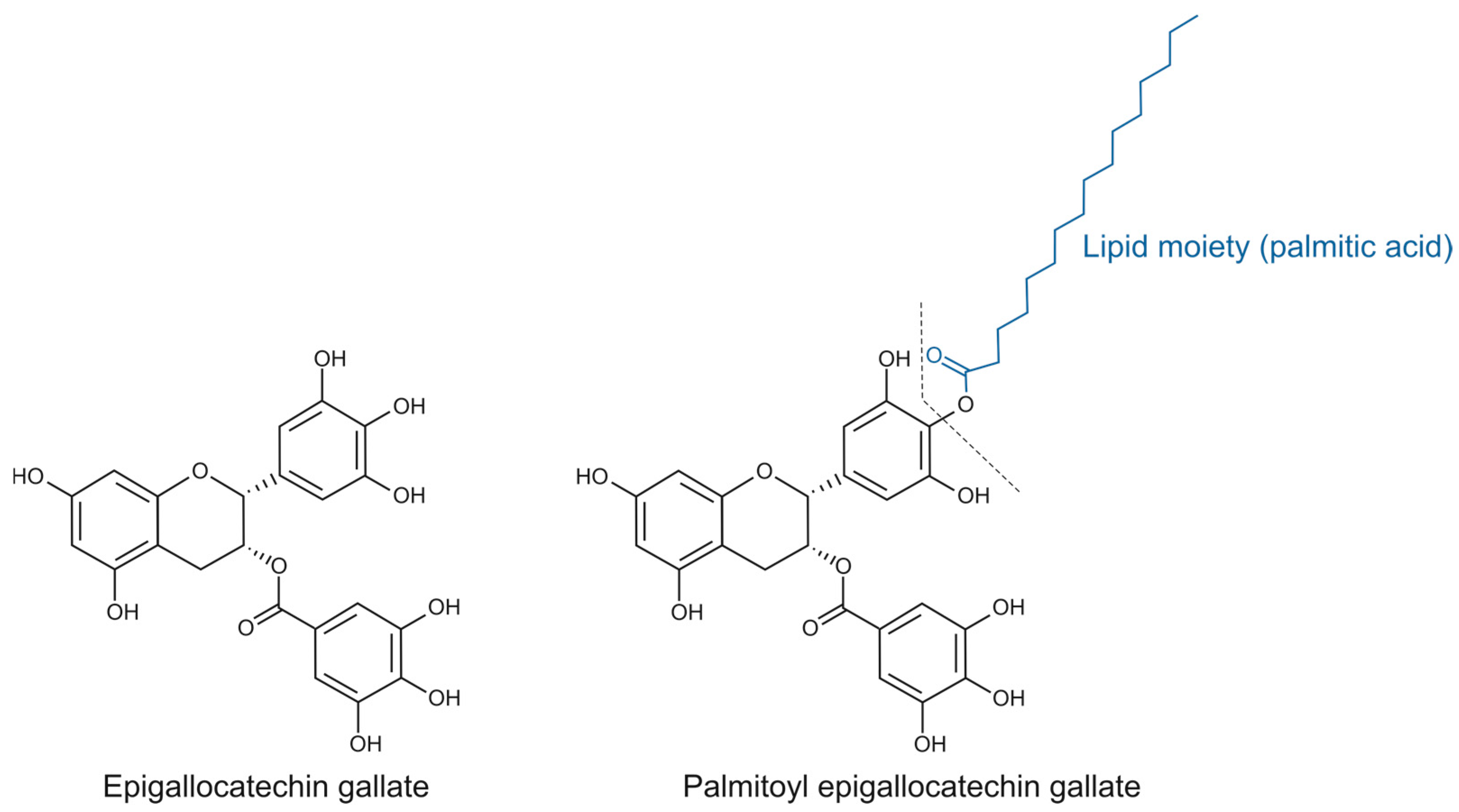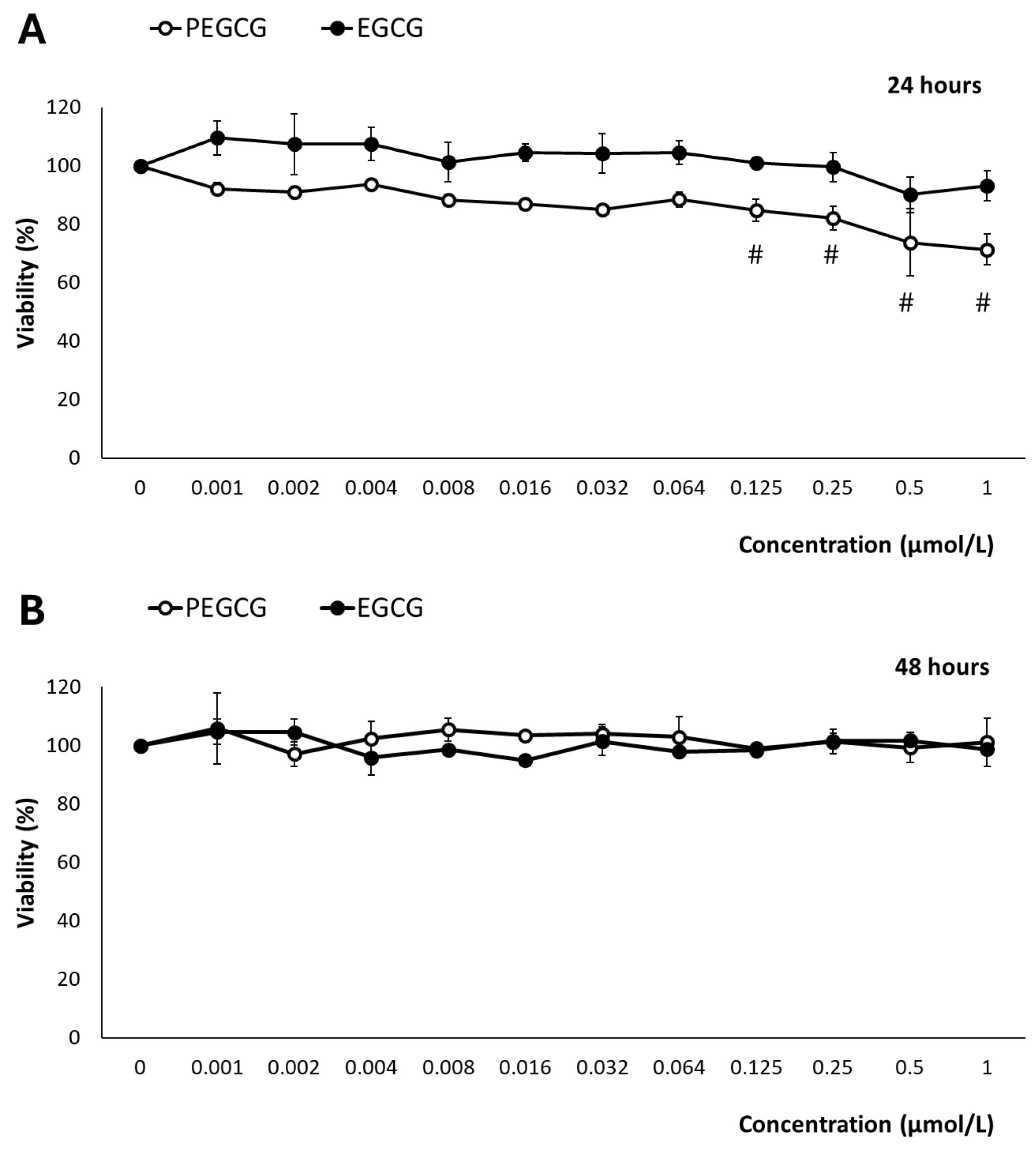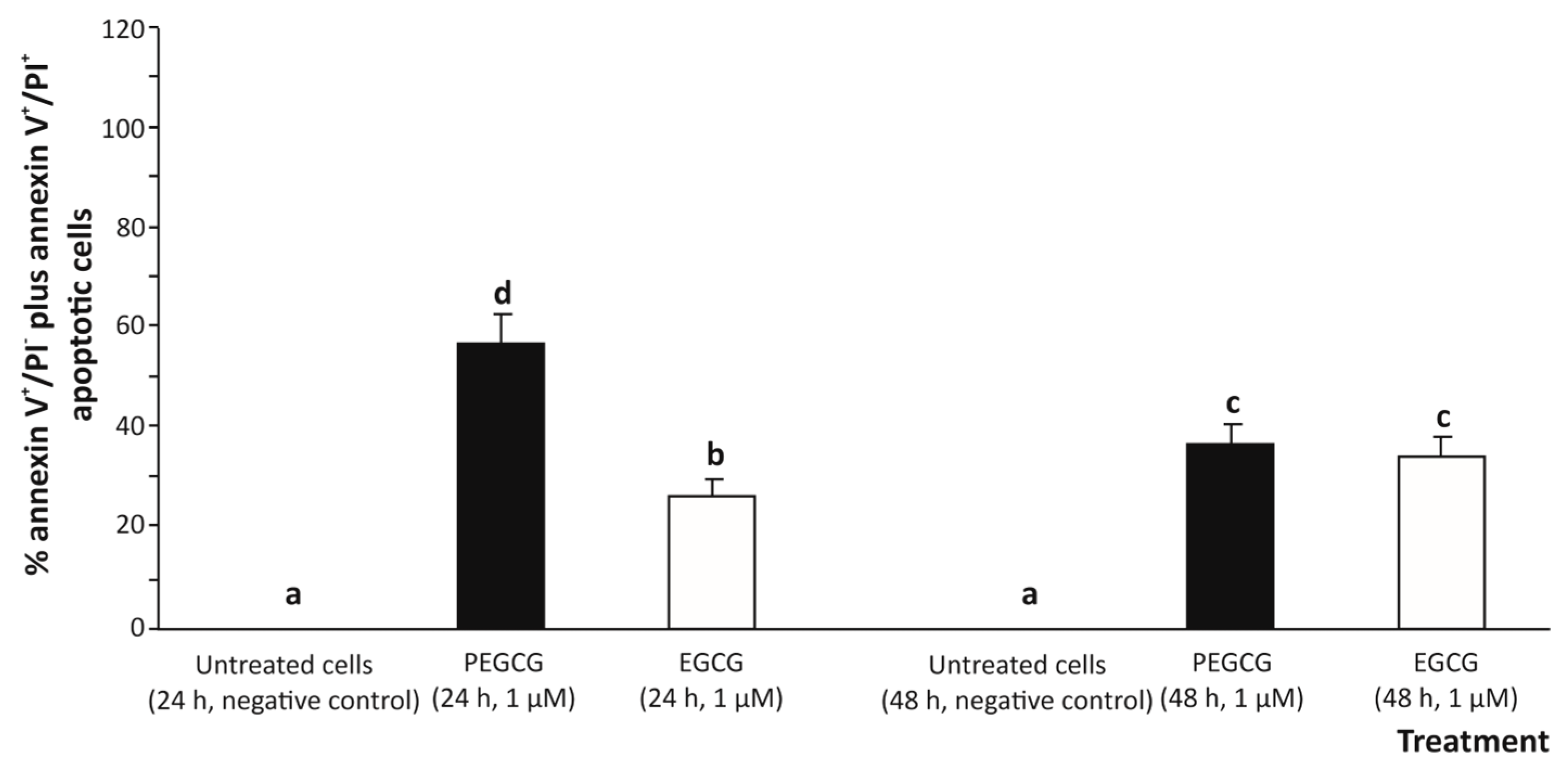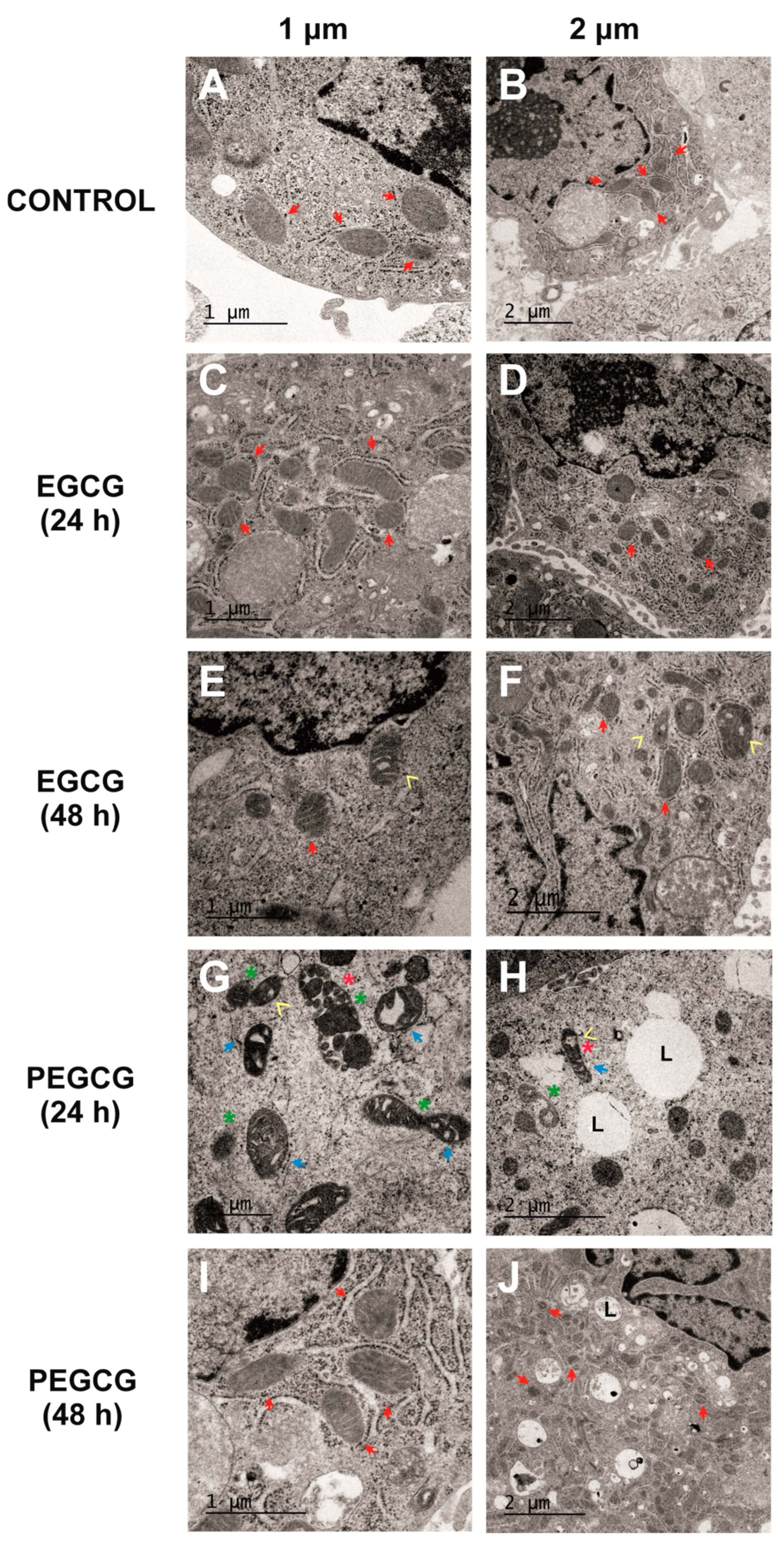Evidence of Time-Dependent Hepatic Cytotoxicity and Mitochondrial Remodelling Induced by Palmitoyl Epigallocatechin Gallate vs. Its Native (Poly)Phenol
Abstract
1. Introduction
2. Results and Discussion
2.1. Impact of Palmitoyl Epigallocatechin Gallate and Epigallocatechin Gallate on Cell Viability
2.2. Cell Death Pathways Analysis: Apoptosis vs. Necrosis
2.3. Ultrastructural Changes in Mitochondria
3. Materials and Methods
3.1. Chemicals and Reagents
3.2. Cell Line and Culture Conditions
3.3. Cytotoxicity Assay
3.4. Double-Colour Flow Cytometry Analysis of Cell Apoptosis: Evaluation of Annexin-v-FITC/Propidium Iodide
3.5. Transmission Electron Microscopic Ultrastructure Analysis of EGCG and PEGCG-Treated HepG2 Cells
3.6. Statistical Analysis
4. Conclusions
Author Contributions
Funding
Institutional Review Board Statement
Informed Consent Statement
Data Availability Statement
Conflicts of Interest
Abbreviations
| ANOVA | Analysis of variance |
| COX-2 | Cyclooxygenase-2 |
| EGCG | Epigallocatechin gallate |
| EMEM | Eagle’s Minimum Essential Medium |
| EDTA | Ethylenediaminetetraacetic acid |
| FBS | Fetal bovine serum |
| FITC | Fluoresceine isothiocyanate |
| HepG2 | Liver hepatocarcinoma cell line |
| MTS | ((3-(4,5-dimethylthiazol-2-yl)-5-(3-carboxymethoxyphenyl)-2-(4-sulfophenyl)-2H-tetrazolium salt) |
| PEGCG | Palmitoyl-epigallocatechin gallate |
| PI | Propidium iodide |
| ROS | Reactive oxygen species |
| SD | Standard deviation |
| TEM | Transmission electron microscopy |
References
- Crauste, C.; Rosell, M.; Durand, T.; Vercauteren, J. Omega-3 Polyunsaturated Lipophenols, How and Why? Biochimie 2016, 120, 62–74. [Google Scholar] [CrossRef]
- Ramadan, M.F. Chemistry and Functionality of Lipo-Phenolics. In Pheno-Phospholipids Lipo-Phenolics, 1st ed.; Ramadán, M.F., Ed.; Springer: Cham, Switzerland, 2021; Volume 1, pp. 35–63. [Google Scholar]
- Zhuang, Y.; Quan, W.; Wang, X.; Cheng, Y.; Jiao, Y. Comprehensive Review of EGCG Modification: Esterification Methods and Their Impacts on Biological Activities. Foods 2024, 13, 1232. [Google Scholar] [CrossRef]
- Mokra, D.; Joskova, M.; Mokry, J. Therapeutic Effects of Green Tea Polyphenol (−)-Epigallocatechin-3-Gallate (EGCG) in Relation to Molecular Pathways Controlling Inflammation, Oxidative Stress, and Apoptosis. Int. J. Mol. Sci. 2023, 24, 340. [Google Scholar] [CrossRef]
- Liu, B.; Kang, Z.; Yan, W. Synthesis, Stability, and Antidiabetic Activity Evaluation of (−)-Epigallocatechin Gallate (EGCG) Palmitate Derived from Natural Tea Polyphenols. Molecules 2021, 26, 393. [Google Scholar] [CrossRef]
- Zhong, Y.; Chiou, Y.S.; Pan, M.H.; Shahidi, F. Anti-Inflammatory Activity of Lipophilic Epigallocatechin Gallate (EGCG) Derivatives in LPS-Stimulated Murine Macrophages. Food Chem. 2012, 134, 742–748. [Google Scholar] [CrossRef]
- Hu, J.; Webster, D.; Cao, J.; Shao, A. The Safety of Green Tea and Green Tea Extract Consumption in Adults—Results of a Systematic Review. Reg. Toxicol. Pharmacol. 2018, 95, 412–433. [Google Scholar] [CrossRef]
- De Oliveira, M.R.; Nabavi, S.F.; Daglia, M.; Rastrelli, L.; Nabavi, S.M. Epigallocatechin Gallate and Mitochondria—A Story of Life and Death. Pharmacol. Res. 2016, 104, 70–85. [Google Scholar] [CrossRef] [PubMed]
- Bernatoniene, J.; Kopustinskiene, D.M. The Role of Catechins in Cellular Responses to Oxidative Stress. Molecules 2018, 23, 965. [Google Scholar] [CrossRef]
- Shi, W.; Li, L.; Ding, Y.; Yang, K.; Chen, Z.; Fan, X.; Jiang, S.; Guan, Y.; Liu, Z.; Xu, D.; et al. The Critical Role of Epigallocatechin Gallate in Regulating Mitochondrial Metabolism. Future Med. Chem. 2018, 10, 795–809. [Google Scholar] [CrossRef] [PubMed]
- Iwasaki, R.; Ito, K.; Ishida, T.; Hamanoue, M.; Adachi, S.; Watanabe, T.; Sato, Y. Catechin, Green Tea Component, Causes Caspase-Independent Necrosis-like Cell Death in Chronic Myelogenous Leukemia. Cancer Sci. 2009, 100, 349–356. [Google Scholar] [CrossRef] [PubMed]
- Bimonte, S.; Albino, V.; Piccirillo, M.; Nasto, A.; Molino, C.; Palaia, R.; Cascella, M. Epigallocatechin-3-Gallate in the Prevention and Treatment of Hepatocellular Carcinoma: Experimental Findings and Translational Perspectives. Drug Des. Dev. Ther. 2019, 13, 611–621. [Google Scholar] [CrossRef] [PubMed]
- Singh, Y.; Salker, M.S.; Lang, F. Green Tea Polyphenol-Sensitive Calcium Signaling in Immune T Cell Function. Front. Nutr. 2021, 7, 616934. [Google Scholar] [CrossRef]
- Landis-Piwowar, K.R.; Huo, C.; Chen, D.; Milacic, V.; Shi, G.; Tak, H.C.; Dou, Q.P. A Novel Prodrug of the Green Tea Polyphenol (−)-Epigallocatechin-3-Gallate as a Potential Anticancer Agent. Cancer Res. 2007, 67, 4303–4310. [Google Scholar] [CrossRef] [PubMed]
- Kucera, O.; Mezera, V.; Moravcova, A.; Endlicher, R.; Lotkova, H.; Drahota, Z.; Cervinkova, Z. In Vitro Toxicity of Epigallocatechin Gallate in Rat Liver Mitochondria and Hepatocytes. Oxidative Med. Cell. Longev. 2015, 2015, 476180. [Google Scholar] [CrossRef] [PubMed]
- Mohammed, R.N.; Khosravi, M.; Rahman, H.S.; Adili, A.; Kamali, N.; Soloshenkov, P.P.; Thangavelu, L.; Saeedi, H.; Shomali, N.; Tamjidifar, R.; et al. Anastasis: Cell Recovery Mechanisms and Potential Role in Cancer. Cell Commun. Signal. 2022, 20, 81. [Google Scholar] [CrossRef]
- McDonald, P.C.; Nagel, J.M.; Dedhar, S. Anastasis, Recovery from the Brink of Death as a Mechanism of Drug Resistance. In Biological Mechanisms and the Advancing Approaches to Overcoming Cancer Drug Resistance; Academic Press: Cambridge, MA, USA, 2021; pp. 251–260. [Google Scholar]
- Patil, A.A.; Bhor, S.A.; Rhee, W.J. Cell Death in Culture: Molecular Mechanisms, Detections, and Inhibition Strategies. J. Ind. Eng. Chem. 2020, 91, 37–53. [Google Scholar] [CrossRef]
- Brauchle, E.; Thude, S.; Brucker, S.Y.; Schenke-Layland, K. Cell Death Stages in Single Apoptotic and Necrotic Cells Monitored by Raman Microspectroscopy. Sci. Rep. 2014, 4, 4698. [Google Scholar] [CrossRef]
- Singh, B.N.; Shankar, S.; Srivastava, R.K. Green Tea Catechin, Epigallocatechin-3-Gallate (EGCG): Mechanisms, Perspectives and Clinical Applications. Biochem. Pharmacol. 2011, 82, 1807–1821. [Google Scholar] [CrossRef]
- Tang, H.M.; Talbot, C.C.; Fung, M.C.; Tang, H.L. Molecular Signature of Anastasis for Reversal of Apoptosis. F1000Research 2017, 6, 43. [Google Scholar] [CrossRef]
- Plecitá-Hlavatá, L.; Engstová, H.; Alán, L.M.; Špaček, T.; Dlasková, A.; Smolková, K.; Špačková, J.; Tauber, J.; Strádalová, V.; Malínský, J.; et al. Hypoxic HepG2 Cell Adaptation Decreases ATP Synthase Dimers and ATP Production in Inflated Cristae by Mitofilin Down-Regulation Concomitant to MICOS Clustering. FASEB J. 2016, 30, 1941–1957. [Google Scholar] [CrossRef]
- Murakami, A. Dose-Dependent Functionality and Toxicity of Green Tea Polyphenols in Experimental Rodents. Arch. Biochem. Biophys. 2014, 557, 3–10. [Google Scholar] [CrossRef] [PubMed]
- Wasilewski, M.; Scorrano, L. The Changing Shape of Mitochondrial Apoptosis. Trend Endocrin. Met. 2009, 20, 287–294. [Google Scholar] [CrossRef] [PubMed]
- Long, L.H.; Kirkland, D.; Whitwell, J.; Halliwell, B. Different Cytotoxic and Clastogenic Effects of Epigallocatechin Gallate in Various Cell-Culture Media Due to Variable Rates of Its Oxidation in the Culture Medium. Mutat. Res. Genet. Toxicol. Environ. Mutagen. 2007, 634, 177–183. [Google Scholar] [CrossRef]
- Ramírez-Sánchez, I.; Rodríguez, A.; Moreno-Ulloa, A.; Ceballos, G.; Villarreal, F. (−)-Epicatechin-Induced Recovery of Mitochondria from Simulated Diabetes: Potential Role of Endothelial Nitric Oxide Synthase. Diab. Vasc. Dis. Res. 2016, 13, 201. [Google Scholar] [CrossRef] [PubMed]
- Medrano-Padial, C.; Puerto, M.; del Mar Merchan-Gragero, M.; Moreno, F.J.; Richard, T.; Cantos-Villar, E.; Pichardo, S. Cytotoxicity Studies of a Stilbene Extract and Its Main Components Intended to Be Used as Preservative in the Wine Industry. Food Res. Int. 2020, 137, 109738. [Google Scholar] [CrossRef]
- Domínguez-Perles, R.; Guedes, A.; Queiroz, M.; Silva, A.M.; Barros, A.I.R.N.A. Oxidative Stress Prevention and Anti-Apoptosis Activity of Grape (Vitis vinifera L.) Stems in Human Keratinocytes. Food Res. Int. 2016, 87, 92–102. [Google Scholar] [CrossRef]
- Medrano-Padial, C.; Puerto, M.; Moreno, F.J.; Richard, T.; Cantos-Villar, E.; Pichardo, S. In Vitro Toxicity Assessment of Stilbene Extract for Its Potential Use as Antioxidant in the Wine Industry. Antioxidants 2019, 8, 467. [Google Scholar] [CrossRef]
- Graham, L.; Orenstein, J.M. Processing Tissue and Cells for Transmission Electron Microscopy in Diagnostic Pathology and Research. Nat. Protoc. 2007, 2, 2439. [Google Scholar] [CrossRef]




Disclaimer/Publisher’s Note: The statements, opinions and data contained in all publications are solely those of the individual author(s) and contributor(s) and not of MDPI and/or the editor(s). MDPI and/or the editor(s) disclaim responsibility for any injury to people or property resulting from any ideas, methods, instructions or products referred to in the content. |
© 2025 by the authors. Licensee MDPI, Basel, Switzerland. This article is an open access article distributed under the terms and conditions of the Creative Commons Attribution (CC BY) license (https://creativecommons.org/licenses/by/4.0/).
Share and Cite
Medrano-Padial, C.; García-Viguera, C.; Domínguez-Perles, R.; Medina, S. Evidence of Time-Dependent Hepatic Cytotoxicity and Mitochondrial Remodelling Induced by Palmitoyl Epigallocatechin Gallate vs. Its Native (Poly)Phenol. Molecules 2025, 30, 2889. https://doi.org/10.3390/molecules30132889
Medrano-Padial C, García-Viguera C, Domínguez-Perles R, Medina S. Evidence of Time-Dependent Hepatic Cytotoxicity and Mitochondrial Remodelling Induced by Palmitoyl Epigallocatechin Gallate vs. Its Native (Poly)Phenol. Molecules. 2025; 30(13):2889. https://doi.org/10.3390/molecules30132889
Chicago/Turabian StyleMedrano-Padial, Concepción, Cristina García-Viguera, Raúl Domínguez-Perles, and Sonia Medina. 2025. "Evidence of Time-Dependent Hepatic Cytotoxicity and Mitochondrial Remodelling Induced by Palmitoyl Epigallocatechin Gallate vs. Its Native (Poly)Phenol" Molecules 30, no. 13: 2889. https://doi.org/10.3390/molecules30132889
APA StyleMedrano-Padial, C., García-Viguera, C., Domínguez-Perles, R., & Medina, S. (2025). Evidence of Time-Dependent Hepatic Cytotoxicity and Mitochondrial Remodelling Induced by Palmitoyl Epigallocatechin Gallate vs. Its Native (Poly)Phenol. Molecules, 30(13), 2889. https://doi.org/10.3390/molecules30132889





